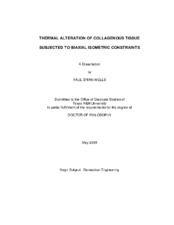| dc.description.abstract | Clinical thermal therapies are widespread and gaining in appeal due to
improved technology of heating devices and promising results. Outcomes of
thermal treatment are often unpredictable and suboptimal, however, due in part
to a lack of appreciation of the underlying biothermomechanics. There is a
pressing need, therefore, to understand better the role of clinically-controllable
parameters on the thermal damage processes of tissue. Heretofore,
researchers have primarily sought to understand this process through various
uniaxial experiments on tissues containing collagen as their primary constituent.
Most biological tissues experience multiaxial loading, however, with complex
boundary constraints inclusive of both isotonic and isometric conditions. The
primary focus of this work is on the isothermal denaturation of fibrillar collagen
subjected to a biaxial isometric constraint.
Results from our tests reveal a complicated process, the kinetics of which
are not easily measured. Evolving isometric contraction forces during heating
do not correlate with resultant mechanical behaviors, as thermal shrinkage does
in biaxial isotonic tests. Furthermore, resultant mechanical behaviors at variousdurations of heating reveal a two phase process with a rate dependent on the
amount of isometric stretch. For tissues heated at 75oC for 15 minutes, at which
point the first phase of mechanical alteration dominates for all constraints herein,
resultant mechanical behaviors correlate well with the amount of isometric
stretch. The correlation is similar to that between isotonic loads and resultant
mechanical behaviors from previous studies. In light of the need for a better
measure of thermal damage in isometric tests, we performed a histological
analysis of tissues heated under varying constraints. Results show a good
correlation between the level of isometric constraint and thermally-induced
histological aberrations. Finally, we demonstrate that our seemingly limited and
qualitative knowledge can be applied well to a specific clinical application:
namely, the use of glycerol as a clearing agent for laser therapies. Our results
suggest that glycerol is safe to use for such therapies because it increases the
thermal stability of fibrillar collagen, and its hyperosmotic effects on mechanical
behavior are fully reversed upon rehydration. | en |


